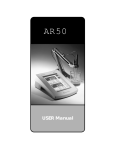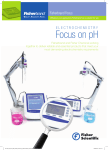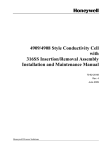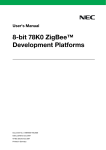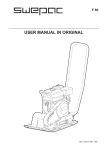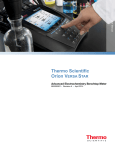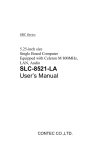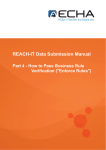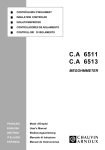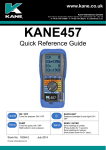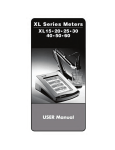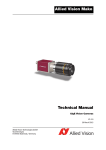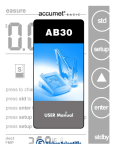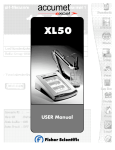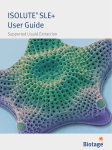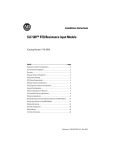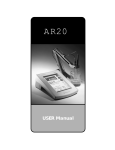Download Accumet
Transcript
Accumet ® Electrochemistry Handbook Accumet® Benchtop Meters pH/mV/Ion/Conductivity AR50 AR25 AR20 AR15 Advanced technology makes them simple, accurate, versatile. Exceptional ease of use: clear language prompts, “HELP” screens and error messages guide you through the measurement process 1. Press “STANDARDIZE” to enter the standardization mode 2. Press “STANDARDIZE” again to perform the standardization Large, easy-to-read LCD readouts with reliable, proven touchscreen technology: responds to a light tap, even with gloves or a pencil That’s all there is to it. In response to your commands, the meter automatically recognizes the buffer, adjusts the buffer value for temperature, waits for a stable reading, enters the data, verifies proper electrode performance, and calibrates the meter. Easily customizable screens: let you display only the data you want and need Throw away your user manual? Two series of meters— Basic and Research Models: to suit your requirements Fisher’s family of Accumet Benchtops has been completely redesigned. Now, they’re not only accurate and versatile, but also the easiest to use, most user-friendly pH/mV/ ion/conductivity meters you can buy. From their sleek, compact design to their oversize LCD readouts to their innovative, highly reliable touchscreen technology (Research Models only), Accumet Benchtop Meters put a wealth of information at your fingertips. Just look at what they offer you. Standardization is ultra simple Standardizing Accumet Benchtop Meters is so simple a child can do it. Here’s all you do: We’d certainly never advise you to do it! But Accumet Benchtop Meters are so easy to use, you probably could. Accumet Benchtop Meters feature simple, intuitive operation, on-screen operational prompts, and context-specific “HELP” screens (Accumet Research Models only) designed to guide you through the meter’s operation in plain, easily understandable language. Plus, not only are Accumet Benchtop Meters accurate, versatile, and easy to use, they’re backed by a full two-year warranty. Should any Accumet Meter fail to perform to specification under normal use during the first two years, it will be repaired or replaced at no charge. Easily customize screens and measurement modes to match your requirements There are two ways to customize the screens and measurement modes on Accumet Benchtop Meters: Research Model Meters lets you customize the screen display to show exactly the parameters that suit your needs. You can edit the date, screen configuration, time, beeper status, and print configuration. Customizing within each meter’s operational modes (pH/mV/ion/conductivity) lets you select appropriate operating parameters, resolution, buffer sets, and similar settings (different for each operating mode) to match your requirements. You can also choose either of two procedural levels: Basic Level displays a reduced set of information and restricts user access to a limited list of setup parameters. Advanced Level allows user-configurable output and access to all setup parameters. Using this feature enables scientists to configure the meter in Advanced Level and have a technician perform measurements in Basic Level, limiting the technician’s ability to change setup parameters. Choosing the System Setup Options menu on Table of Contents Accumet Benchtop Meters 2–11 pH Theory and Measurements 14–15 Metallic Electrodes, ORP Theory and Measurements 16 Accumet Electrode Specifications 19–23 2 Accumet Portable Meters Conductivity Theory and Measurements ISE Theory and Measurements Buffers, Solutions, Accessories 12–13 16 16–18 24 pHree Trial Offer makes it so easy to try one We’re so sure you’ll agree that Accumet® Meters offer the best performance, versatility, and value available that we invite you to try one FREE for 30 days with no risk and no obligation. To schedule your Accumet pHree Trial, contact AR10 AB30 Choose the meter that makes your job easiest Two series of Accumet Benchtop Meters are available to match any laboratory’s needs: AB15 What’s more, Accumet Research Meters (except Model AR10) are the only meters of their type to offer exciting, easy-to-use touchscreen technology—proven reliable in thousands of retail applications worldwide. (“TOUCH” areas of the screen will withstand millions of touches.) your Fisher Sales Representative. Just touch the scratch-resistant screen with your fingertip to display the information you need, including current measurement value, stability indicator, buffers or standards in use with time/date stamp, plain language prompts, date, time, temperature—and much more! Accumet Research (AR) Benchtop Meters • Five single- and multi-function models • Unparalleled selection of user options lets you customize the meter to your application • Extra-large, scratch-resistant LCD touch screens (all models except AR10) respond to a light tap, even with gloves or a pencil • Two procedural levels to fit your needs • Configurable display shows only data you need • Plain language prompts and context-specific “HELP” screens guide you through • Data acquisition via bidirectional communication with computer or printer • Multiple language option: English, German, French, or Spanish built in • Rugged ABS plastic housings resist impacts and chemicals Current measurement value Stability indicator Buffers or standards in use, with time and date stamp Accumet Basic (AB) Benchtop Meters • Two models to choose from • Accurate pH, mV, temperature (AB15) and conductivity measurement (AB30) at an affordable price • Extra-large LCD shows results clearly • Five soft-touch membrane switches control all operations • On-screen plain language prompts and error messages make measurement easier Plain language prompts Date and time Temperature The biggest LCD readouts in their class—plus reliable, user-friendly touchscreen technology No more squinting at tiny displays. With the biggest LCD readouts in their class, Accumet Benchtop Meters display the information you need precisely and clearly. Accumet Basic Benchtop Meters feature a softtouch, membrane switch keypad for operation. It’s tough, chemical-resistant, and simple to use. 3 The Accumet® Research Model AR50 pH/mV/Ion/Conductivity Meter Now, it’s easy to put a complete electrochemical lab at your fingertips • Powerful and versatile—make two different measurements simultaneously • Automatically corrects for temperature fluctuations with separate ATC probe in each channel An advanced design and incredible ease of use make the new Accumet AR50 the most versatile, reliable meter of its type you can buy today. • Exceptionally easy to use • Data acquisition via bidirectional communication with computer or printer The AR50 offers you the advantages and versatility of having a research-grade pH, mV, ion, and conductivity meter, all in a single instrument, providing you with a dedicated system for a wide range of electrochemical analyses. • Extra-large, scratch- and chemicalresistant LCD readout with dual display • Reliable touchscreen technology responds to a light tap of your finger • Multiple language option: English, German, French, or Spanish built in • Select from two procedural levels to match your requirements • Uses standard glass or AccuFet® electrodes with no adapters required • Accepts 2-cell and 4-cell conductivity probes • Built-in replatinizing circuit Current measurement value Stability indicator Status box Buffer status indicator Date and time 4 Features • The largest display available; yet compact design saves valuable benchtop space • User prompts and context-specific “HELP” screens easily guide user through operation • Extensive setup screens allow you to customize the meter to your needs • Autocalibrates with up to 5 pH buffers from any of 3 standard sets and 15 different buffers; also accepts custom buffers and manual calibration • Innovative touchscreen makes it versatile and easy to use • Dual channel meter allows you to measure two parameters at once and view results from both channels on screen simultaneously • Reads pH to 0.001, mV to 0.1, plus conductivity, resistivity, salinity, and TDS • Reads ISE in ppm, %, mg/mL, and mole/L • Direct and indirect ISE measurements, including known addition and subtraction, and analate addition and subtraction methods • Extensive GLP capabilities with customizable printer or computer output and 250 reading datalog capability • Print setup allows you to print exactly what you want, exactly when you want, not just a screen dump • Time can be displayed in 12- or 24-hour formats and date in U.S. or international format • Accepts standard BNC glass electrodes as well as an AccuFet electrode directly—no need for an adapter • Accepts two-cell and four-cell conductivity probes • Built-in replatinizing circuit • Automatically corrects for temperature fluctuations with separate ATC (Automatic Temperature Compensation) probe in each channel Simple customization lets you fit the system to your needs You can easily customize the AR50 Meter screen to set measurement mode operating parameters, display only the information you need, or match your operating needs. There are two ways to do this: • Choosing the “SYSTEM SETUP OPTIONS” menu lets you customize and simplify the screen displays to show exactly the parameters that suit your needs. You can edit the date, screen configuration, time, beeper status, and print configuration. • Customizing within each of the AR50’s operating modes (pH/mV/ion/conductivity) lets you select Specifications and Ordering Information Displays Screen size Measurement display height Temp./etc. display height Memory Internal diagnostics Programmable data output Print interval Programmable alarm pH mode Range Resolution Relative accuracy Auto/manual buffer recognition Calibration points mV mode Range Resolution Accuracy Ion mode Range Resolution Relative accuracy Calibration points Incremental methods Conductivity mode Cell constants Ranges: Conductivity Resistivity Salinity Accuracy Temperature mode Range Resolution Accuracy Inputs/outputs and set the operating parameters you wish to display, including resolution, buffer sets, and similar settings (different for each operating mode) to match your requirements. You can also choose either of two procedural levels: Basic Level displays a reduced set of information and limits user access to the full list of setup parameters; Advanced Level allows user-configurable output and access to all setup parameters. Using this feature, scientists can configure the meter in Advanced Level and have a technician perform measurements in Basic Level, limiting the technician’s ability to change setup parameters. 640 x 480 LCD 41/2W x 69H 3 /49H 1 /49H 250 data points Yes Output on stable, time, manual 1 to 9,999 sec. Yes -2.000 to +20.000 0.1/0.01/0.001 ±0.002 Yes 5 ±1800.0 0.1 ±0.1 1 x 10-6 to 9.99 x 1010 4 significant figures ±0.17n% 5 KA, KS, AA, AS 0.1/1.0/10 0 to 3 x 105µS/cm 30megohm-cm to 100megohm-cm 2 to 42ppt ±0.5% -5.0° to +105°C 0.1°C ±0.2°C 2 BNC, 2 Pin, 2 ATC, 2-pin conductivity, bidirectional RS-232, 2 DIN (for FET and 4-cell conductivity) Meter size 61/2W x 91/4L x 31/29H; 165 x 235 x 89mm Meter weight 2.34 lb. (1.1kg) Description Catalog No. AR50 Meter Kit: 13-636-AR50 includes meter, Ag/AgCl combination pH electrode, ATC probe, electrode support arm and bracket, user manual, and power supply. AR50B Meter Kit: 13-636-AR50B includes meter, AccuTupH+® rugged bulb calomel combination pH electrode for Tris-buffer applications, ATC probe, electrode support arm and bracket, user manual, and power supply. AR50A Meter only: 13-636-AR50A includes meter, electrode support arm and bracket, user manual, and power supply. 5 The Accumet® Research Model AR25 pH/mV/Ion Meter Dual channels let you measure and view two parameters at once • Powerful—measure pH and ion simultaneously • Intuitive user interface makes it exceptionally easy to use • Extra-large, scratch- and chemicalresistant LCD readout with dual display • Reliable touchscreen technology responds to a light tap of your finger • Automatically corrects for temperature fluctuations with separate ATC probe in each channel • Data acquisition via bidirectional communication with computer or printer • Multiple language option: English, German, French, and Spanish built in • Uses standard glass or an AccuFet electrode with no adapter required The Accumet AR25 Meter is fully equipped for the most demanding pH and ion measurements, yet is so simple to use almost anyone can do it. It offers Accumet accuracy and reliability plus innovative, dependable touchscreen technology, proven in thousands of applications worldwide. Its user-friendly design gives you an unparalleled range of user-determined setup, screen display, data storage, and printing options. Its dual-channel design is like having two meters in one. You can display one channel at a time, or toggle to split screen for simultaneous viewing. For the lab that needs the versatility of a research grade pH meter and an ion meter, it’s an easy choice. Features • The largest display available; yet compact design saves valuable bench space • User prompts and context-specific “HELP” screens easily guide user through operation • Extensive setup screens allow you to customize the meter to your needs • Autocalibrates with up to 5 pH buffers from any of 3 standard sets and 15 different buffers; also accepts custom buffers and manual calibration • Innovative touchscreen makes it versatile and easy to use • Dual channel meter allows you to measure two parameters at once, and view results from both channels on screen simultaneously • Reads pH to 0.001, mV to 0.1 • Reads ISE in ppm, %, mg/mL, and mole/L • Direct and indirect ISE measurements, including known addition and subtraction, and analate addition and subtraction methods • Extensive GLP capabilities with customizable printer or computer output and 250 reading datalog capability • Print setup allows you to print exactly what you want, when you want it, not just a screen dump • Time can be displayed in 12- or 24-hour format, and date can be displayed in U.S. or international format • Accepts standard glass electrodes or an AccuFet® electrode directly—no need for an adapter • Automatically corrects for temperature fluctuations with ATC probe 6 Specifications and Ordering Information Displays 640 x 480 LCD Screen size 41/2W x 69H 3 Measurement display height /49H 1 Temp./etc. display height /49H Menu options Extensive Memory 250 data points Internal diagnostics Yes Programmable data output Output on stable, time, manual Print interval 1 to 9,999 sec. Programmable alarm Yes pH mode Range Resolution Relative accuracy Auto/manual buffer recognition Calibration points mV mode Range Resolution Accuracy Ion mode Range Resolution Relative accuracy Calibration points Incremental methods Temperature mode Range Resolution Accuracy Inputs/outputs -2.000 to +20.000 0.1/0.01/0.001 ±0.002 Yes 5 ±1800.0 0.1 ±0.1 1 x 10-6 to 9.99 x 1010 4 significant figures ±0.17n% 5 KA, KS, AA, AS -5.0° to +105.0°C 0.1°C ±0.2°C 2 BNC, 2 Pin, 2 ATC, bidirectional RS-232, DIN (for FET) Meter size 61/2W x 91/4L x 31/29H 165 x 235 x 89mm Meter weight 2.34 lb. (1.1kg) Description Catalog No. AR25 Meter Kit: 13-636-AR25 includes meter, Ag/AgCl combination pH electrode, ATC probe, electrode support arm and bracket, user manual, and power supply. AR25B Meter Kit: 13-636-AR25B includes meter, AccuTupH+® rugged bulb Accu•pHast® combination pH electrode for Tris-buffer applications, ATC probe, electrode support arm and bracket, user manual and and power supply. AR25A Meter only: 13-636-AR25A includes meter, electrode support arm and bracket, user manual, and power supply. The Accumet® Research Model AR20 pH/mV/Conductivity Meter Same accuracy as our top model—pH, mV, and conductivity readout • Large, easy-to-use LCD touchscreen displays information clearly • Exceptional user interface with plain language prompts make it a breeze to use • Select from two procedural levels to suit your needs • Accepts 2-cell and 4-cell conductivity probes • Built-in replatinizing circuit • Automatically corrects for temperature fluctuations with ATC probe • Data acquisition via bidirectional communication with computer or printer • Multiple language option: English, German, French, or Spanish built in The newly-designed Accumet AR20’s powerful conductivity and pH modes provide the same performance and ease of use as our top-of-theline AR50. You also get the convenience and benefits of our extra-large touchscreen technology, with an unequaled range of userdetermined setup, screen display, data storage, and printing options. Features • The largest display available; yet compact design saves valuable bench space • On-screen prompts in plain language and context-specific “HELP” screens easily guide user through operation • Autocalibrates with up to 5 pH buffers from any of 3 standard sets and 15 different buffers; also accepts custom buffers, and manual calibration • Innovative touchscreen makes it versatile and easy to use • Reads pH to 0.001, mV to 0.1, plus conductivity, resistivity, salinity, and TDS • Extensive GLP capabilities with customizable printer or computer output and 250 reading datalog capability • Autoranging capability • Print setup allows you to print exactly what you want, when you want, not just a screen dump • Time can be displayed in 12- or 24-hour format; date can be displayed in U.S. or international formats • Accepts standard glass electrode or an AccuFet® electrode directly—no need for an adapter Specifications and Ordering Information Displays 640 x 480 LCD Screen size 41/2W x 69H 3 Measurement display height /49H 1 Temp./etc. display height /49H Memory 250 data points Internal diagnostics Yes Programmable data output Output on stable, time, manual Print interval 1 to 9,999 sec. Programmable alarm Yes pH mode Range -2.000 to +20.000 Resolution 0.1/0.01/0.001 Relative accuracy ±0.002 Auto/manual buffer recognition Yes Calibration points 5 mV mode Range ±1800.0 Resolution 0.1 Accuracy ±0.1 Conductivity mode Cell constants 0.1/1.0/10 Ranges: Conductivity 0 to 3 x 105µS/cm Resistivity 30megohm-cm to 100megohm-cm Salinity 2 to 42ppt Accuracy 0.5% Temperature mode Range -5.0° to +105.0°C Resolution 0.1°C Accuracy ±0.2°C Inputs/outputs BNC, Pin, ATC, 2-pin conductivity, bidirectional RS-232, 2 DIN (for FET and 4-cell conductivity) Meter size 61/2W x 91/4L x 31/29H 165 x 235 x 89mm Meter weight 2.34 lb. (1.1kg) Description Catalog No. AR20 Meter Kit: 13-636-AR20 includes meter, Ag/AgCl combination pH electrode, ATC probe, electrode support arm and bracket, user manual, and power supply. AR20B Meter Kit: 13-636-AR20B includes meter, AccuTupH+® rugged bulb Accu•pHast® combination pH electrode for Tris-buffer applications, ATC probe, electrode support arm and bracket, user manual and power supply. AR20A Meter only: 13-636-AR20A includes meter, electrode support arm and bracket, user manual, and power supply. 7 The Accumet® Research Model AR15 pH/mV/°C Meter An easy-to-use, dedicated pH/mV meter for research-grade measurements • Large, scratch- and chemicalresistant LCD readout with reliable touchscreen technology for ease of operation • Intuitive operation with on-screen, plain language prompts and “HELP” screens that guide you through the measurement process • Data acquisition via bidirectional communication with computer or printer • Multiple language option: English, German, French, or Spanish built in The Accumet AR15 Meter measures pH and mV with all the power and ease of use of the top-of-the-line AR50. It automatically recognizes USA, Euro, NIST, or custom buffers. Its remarkable user interface makes it exceptionally easy to use, and a full complement of plain-language prompts and “HELP” screens guide you through the measurement process. Features • Innovative, reliable touchscreen technology makes it versatile and easy to use • User prompts and context-specific “HELP” screens easily guide user through operation • Extensive setup screen allows you to customize the meter to your needs • Autocalibrates up to 5 pH buffers from any of 3 standard sets and 15 different buffers; also accepts custom buffers and manual calibration • Reads pH to 0.001 and mV to 0.1 • Extensive GLP capabilities with customizable printer or computer output and 250 reading datalog capability • Print setup allows you to print exactly what you want, when you want it, not just a screen dump • Time can be displayed in 12- or 24-hour format; date can be displayed in U.S. or international format • Accepts standard glass electrode or AccuFet® electrode directly—no need for an adapter • Automatically corrects for temperature fluctuations with ATC probe 8 Specifications and Ordering Information Displays 640 x 480 LCD Screen size 41/2W x 69H 3 Measurement display height /49H 1 /49H Temp./etc. display height Memory 250 data points Internal diagnostics Yes Programmable data output Output on stable, time, manual Print interval 1 to 9,999 sec. Programmable alarm Yes pH mode Range Resolution Relative accuracy Auto/manual buffer recognition Calibration points mV mode Range Resolution Accuracy Temperature mode Range Resolution Accuracy Inputs/outputs -2.000 to +20.000 0.1/0.01/0.001 ±0.002 Yes 5 ±1800.0 0.1 ±0.1 -5.0° to +105.0°C 0.1°C ±0.2°C BNC, Pin, ATC, bidirectional RS-232, DIN (for FET) Meter size 61/2W x 91/4L x 31/29H 165 x 235 x 89mm Meter weight 2.34 lb. (1.1kg) Description Catalog No. AR15 Meter Kit: 13-636-AR15 includes meter, Ag/AgCl combination pH electrode, ATC probe, electrode support arm and bracket, user manual, and power supply. AR15B Meter Kit: 13-636-AR15B includes meter, AccuTupH® rugged bulb double-junction combination pH electrode for Tris-buffer applications, ATC probe, electrode support arm and bracket, user manual, and power supply. AR15A Meter only: 13-636-AR15A includes meter, electrode support arm and bracket, user manual, and power supply. The Accumet® Research Model AR10 pH/mV/°C Meter Performance, reliability, and economy in an easy-to-use digital pH meter • Simple design and operation plus research-grade performance Features • Sleek, modern design • Solid-state circuitry with digital display and rotary knobs • Compact—small footprint saves valuable bench space The Accumet AR10 Meter gives you reliable, research-grade pH and mV measuring capabilities in a package that is ideal for classrooms and industrial labs. A big, four-digit LCD makes reading measurements easy, and fourknob rotary control makes it simple to use. • Reads pH to 0.01 and mV to 1 • Ideal for educational use • Automatically corrects for temperature fluctuations with ATC probe Replacement Parts and Accessories for Accumet AR Series Benchtop Meters Description For Accumet AR Series Benchtop Meters pH combination electrode, Ag/AgCl, single junction, glass body, BNC connector; replacement for AR10, AR15, AR20, AR25, AR50 AccuFet® solid-state pH/ATC combination electrode, Ag/AgCl ATC probe, stainless steel; for all AR Series meters Electrode support arm for all AR Series meters Electrode arm bracket for all AR Series meters Power Supply—115V, 60Hz, US plug For Accumet AR50, AR25, AR20, AR15 Benchtop Meters Printer, including printer, cable, ribbon, paper. For 115V Printer Paper Printer Replacement Ribbon Printer Cable Computer Cable for AR Series (9-pin to 9-pin) Catalog No. 13-620-285 13-620-755 13-620-19 13-637-671 13-637-671A 13-636-100 4-Cell Conductivity Cell Glass Body Epoxy Body --13-620-163 13-620-164 pH mode Range Resolution Relative accuracy Manual buffer recognition Calibration points mV mode Range Resolution Accuracy Temperature mode Range Resolution Accuracy -1.99 to +19.99 0.01 ±0.02 Yes 2 ±1800.0 1 ±1 0°C to 100.0°C 0.1°C ±0.5°C Inputs/outputs BNC, Pin, ATC, Recorder, DIN (for FET) Meter size 61/2W x 91/4L x 31/29H 165 x 235 x 89mm Meter weight 13-637-670 13-637-669 13-637-668 13-637-667 13-637-680 Conductivity Cells for AB30, AR20, AR50 2-Cell Conductivity Cell Glass Body Epoxy Body Accumet Immersion Type Conductivity Electrodes Cell constant 0.1cm-1 13-620-156 13-620-161 Cell constant 1.0cm-1 13-620-155 13-620-160 Cell constant 10.0cm-1 13-620-157 13-620-162 Specifications and Ordering Information Displays 4-digit LCD Screen size 21/4W x 19H 3 Measurement display height /49H Keypad controls 4-knob rotary Programmable data output Recorder (±1800mV) 2.34 lb. (1kg) Description Catalog No. AR10 Meter Kit: 13-636-AR10 includes meter, Ag/AgCl combination pH electrode, ATC probe, electrode support arm and bracket, user manual, and power supply. AR10A Meter only: 13-636-AR10A includes meter, electrode support arm and bracket, user manual, and power supply. --13-620-165 13-620-166 9 The Accumet® Basic Model AB30 Conductivity/°C Meter An accurate, affordable, easy-to-operate dedicated conductivity meter • Easy-to-read custom LCD—displays information clearly • Shows measurements in conductivity, resistivity, or total dissolved solids units Features • Reads conductivity, resistivity, and total dissolved solids to 4 significant figures • Large display shows measurement and temperature at all times • Clear user interface with plain language prompts make it a breeze to use • Easy-to-use operation with user prompts on screen, stability indicators, and error messages The Accumet Basic AB30 Conductivity Meter features a large digital display that shows stability indicators as well as user prompts and error messages in plain language, making it exceptionally easy to use. The AB30 Meter measures conductivity, resistivity, and total dissolved solids, and all measurements are corrected for temperature fluctuations with the ATC probe (supplied with kit). • Automatically corrects for temperature fluctuations with ATC probe • Accepts two-cell and four-cell conductivity probes • Small, compact size conserves valuable bench space Specifications and Ordering Information Display Custom LCD Screen size 3W x 41/49H 3 Measurement display height /49H 5 /169H Temp./etc. display height Keypad controls 5-key soft touch membrane Conductivity mode Cell constants Ranges: Conductivity Resistivity TDS Accuracy Temperature mode Range Resolution Accuracy Inputs 0.1, 1.0, 10 0 to 3 x 105µS/cm 30megohm-cm to 100megohm-cm 0 to 1.8 x 105ppm ±0.5% -5.0° to +105.0°C 0.1°C ±0.5°C 2-cell (2 pins) conductivity, 4-cell (DIN) conductivity, ATC probe Meter size 51/2W x 71/2L x 31/49H 140 x 191 x 83mm Replacement Parts and Accessories for Accumet AB Series Benchtop Meters Description pH/ATC electrode, Ag/AgCl, single junction, polypropylene, BNC connector; replacement for AB15 pH/ATC electrode, calomel, single junction, polypropylene, BNC connector; replacement for BioBasic AB15B AccuFet® solid-state pH/ATC combination electrode, Ag/AgCl ATC probe, stainless steel; for all AB Series meters Electrode support arm for all AB Series meters Electrode arm bracket for all AB Series meters Power Supply—115V, 60Hz, US plug Catalog No. 13-620-530 13-620-531 13-620-755 13-620-19 13-637-671 13-637-671A 13-636-100 Conductivity Cells for AB30 2-Cell Conductivity Cell Glass Body Epoxy Body Accumet Immersion Type Conductivity Electrodes Cell constant 0.1cm-1 13-620-156 13-620-161 Cell constant 1.0cm-1 13-620-155 13-620-160 Cell constant 10.0cm-1 13-620-157 13-620-162 10 4-Cell Conductivity Cell Glass Body Epoxy Body --13-620-163 13-620-164 --13-620-165 13-620-166 Meter weight 1.86 lb. (0.8kg) Description Catalog No. AB30 Meter Kit: 13-636-AB30 includes meter, ATC probe, electrode support arm and bracket, user manual, and power supply. AB30A Meter only: 13-636-AB30A includes meter, electrode support arm and bracket, user manual, and power supply. The Accumet® Basic Model AB15 pH/mV/°C Meter Intuitive, simple operation, and high accuracy in a compact, affordable meter • Same quality as our top-of-the-line AR50 Research Meter Features • Largest LCD readout in its class • Measures pH, mV, and relative mV to 0.01 pH and 1mV • Accepts standard glass or AccuFet® electrode directly with no adapter needed • Large display shows pH or mV and temperature at all times Easy operation, accuracy, and affordability set the Accumet Basic AB15 Meter apart from the competition. A large custom LCD makes the AB15 Meter easy to read, while plain language prompts and error messages guide the user through measurements. A rugged, chemical-resistant fivebutton soft touch membrane keypad controls all operations. The AB15 Meter automatically corrects for temperature fluctuations using an ATC probe. The AB15 Meter Kit includes Ag/AgCl combination pH/ATC electrode. Life science and other researchers using Tris buffers can choose the AB15B BioBasic Meter Kit, complete with calomel electrode with built-in ATC probe. For laboratories needing a basic, accurate, easy-to-use pH/mV meter, the AB15 Meter is the perfect choice. • Autocalibrates with up to 5 pH buffers from any 3 standard sets and 15 different buffers • Easy-to-use operation with user prompts, stability indicators, and error messages on screen • Accepts a standard glass electrode or AccuFet® electrode directly—no adapter needed • Automatically corrects for temperature fluctuations with ATC probe • Standardization curves for standard glass and the AccuFet electrode stored in memory—switch electrodes quickly with no need to restandardize • Small, compact size conserves valuable bench space Specifications and Ordering Information Display Custom LCD Screen size 3W x 41/49H 3 /49H Measurement display height 5 Temp./etc. display height /169H Keypad controls 5-key soft touch membrane Internal diagnostics Yes pH mode Range Resolution Relative accuracy Automatic buffer recognition Calibration points mV mode Range Resolution Accuracy Temperature mode Range Resolution Accuracy Inputs -1.99 to +19.99 0.1/0.01 ±0.01 Yes 5 ±1800.0 1 ±0.2 -5.0°C to +105.0°C 0.1°C ±0.2°C BNC, Pin, ATC, DIN (for FET) Meter size 51/2W x 71/2L x 31/49H 140 x 191 x 83mm Meter weight 1.86 lb. (0.8kg) Current measurement value Stability indicator Buffer standardization (pH mode) Plain language prompts Temperature indicator Description Catalog No. AB15 Meter Kit: 13-636-AB15 includes meter, Ag/AgCl combination pH/ATC electrode, electrode support arm and bracket, user manual, and power supply. AB15B BioBasic Meter Kit: 13-636-AB15B includes meter, calomel combination pH/ATC electrode for Tris-buffer applications, electrode support arm and bracket, user manual, and power supply. AB15A Meter only: 13-636-AB15A includes meter, electrode support arm and bracket, user manual, and power supply. Easy-to-read liquid crystal display is the largest in its class The AB15 Meter’s large, liquid crystal display (LCD) makes it exceptionally easy to use and read. Operation is controlled by only five soft touch membrane keys. 11 Accumet® Portable Meters pH/mV/Ion/°C AP61 AP62 AP63 Accurate, portable, easy to use. Precise measurements any time, anywhere Accumet Portable (AP) pH meters are so compact and easy to use, you can test for pH, mV, Ion, and °C just about anywhere. Their microprocessorbased accuracy and precision, coupled with their rugged, waterproof design make them ideal for a variety of remote testing applications. Offering up to five calibration points, Accumet Portable pH meters provide the ultimate in portable pH measurement. Small enough to fit in your shirt pocket • Three models to match your remote testing and sampling requirements • Large, easy-to-read LCD readouts • Same simple, intuitive operation as Accumet Basic Series Benchtop Meters • Six-button, soft touch keypad • Ergonomic design makes them comfortable to hold • Waterproof to IP67 standards— in fact, they float! Compact, rugged Accumet Portable pH meters can be used almost anywhere, from the R&D lab to the factory floor to the job site. Their trim shape and rubberized, wraparound grips make them comfortable to hold and operate with just one hand. Choose the AP61 for pH-only measurements, the AP62 for pH/mV, or the AP63 for pH, mV, or ion applications. All models also measure temperature in °C. Easy to use, comfortable to hold A user interface similar to that used in Accumet Basic Benchtop meters makes Accumet Portable pH meters exceptionally easy to operate. Six sealed, soft-touch entry keys let you scroll easily through menu options. pH mode features selectable resolution to 0.01, automatic temperature compensation, automatic recognition of 5 buffers, and five-point calibration. (The AP63 also features automatic recognition of 5 standards and five-point calibration in ion mode.) Plain language onscreen prompts and error messages make getting good results easy, even for inexperienced operators. Rugged and waterproof A tough, ABS plastic housing lets Accumet Portable pH meters take hard use in stride. In fact, to help you handle even the most difficult remote measurement applications, they’re waterproof to IP67 standards and will even float if dropped in water. Accumet Portable pH meters operate from a 9V battery or with an optional AC adapter. Backed by a full two-year warranty Not only are Accumet Portable meters accurate, versatile, and easy to use, they’re backed by a full two-year warranty. Should any Accumet meter fail to perform to specification under normal use during the first two years, it will be repaired or replaced at no charge. Replacement Parts and Accessories for Accumet AP60 Series Portable Meters Description Power Supply, 115V, 60Hz, US plug pH/ATC electrode, Ag/AgCl, single junction, polypropylene, refillable pH/ATC electrode, calomel, single junction, polypropylene, refillable pH/ATC electrode, double junction, epoxy body, gelled Ag/AgCl electrolyte ATC probe, stainless steel for all AP60 Series meters Accumet Portable Lab (Carrying Case) Catalog No. 13-636-100 13-620-AP50 13-620-AP51 13-620-AP52 13-620-AP53 13-636-AP69 Note: Accumet AP Series Portable Meters are only waterproof to IP67 standards when used with AP Series electrodes above, and with AC adapter cap in place. Meters are not waterproof when used with AC adapter. 12 Specifications and Ordering Information Accumet Portable AP61 pH/°C Meter Displays Custom LCD Screen size 115/16W x 21/29H 7 Measurement characters /169H 1 Other data characters /49H Keypad controls 6-key membrane Internal diagnostics Self-test, error message Waterproofing IP67† pH mode Range -1.99 to +19.99 Resolution 0.1/0.01 Relative accuracy ±0.01 Auto buffer recognition 2, 4, 7, 10, 12 Calibration points 1 to 5 Temperature mode Range -5.0° to +100.0°C Resolution 0.1°C Relative accuracy ±0.3°C Compensation Automatic pHree Trial Offer makes it so easy to try one We’re so sure you’ll agree that Accumet® Portable meters offer the best performance, versatility, and value available that we invite you to try one FREE for 30 days with no risk and no obligation. To schedule your Accumet pHree Trial, contact your Fisher Sales Representative. Inputs BNC, ATC Electrical requirements 9V battery or optional AC adapter Battery life >200 hr. Mode Measurement value Stability indicator Temperature Plain language prompts Buffers or standards in use Simple 6-button operation Description Catalog No. AP61 Meter Kit‡ AP61A Meter only‡ 13-636-AP61 13-636-AP61A Specifications and Ordering Information Accumet Portable AP62 pH/mV/°C Meter Same specifications as Model AP61 plus: mV mode Range 0 to ±999 Resolution 1.0 Relative accuracy ±0.1 Description Catalog No. AP62 Meter Kit‡ AP62A Meter only‡ 13-636-AP62 13-636-AP62A Specifications and Ordering Information Accumet Portable AP63 pH/mV/Ion/°C Meter Same specifications as Model AP62 plus: Ion mode Range 1 x 10-3 to 9.99 x 104 Relative accuracy ±0.17n% Calibration points 5 Resolution 2 or 3 significant digits Description Catalog No. AP63 Meter Kit‡ AP63A Meter only‡ 13-636-AP63 13-636-AP63A †IP67 Standard: Meter can be submerged for 30 minutes to a depth of 1m and still remain operational. ‡Meter only versions include meter, 9V battery, and user manual. Meter Kits include meter, 9V battery, Accumet liquid-filled polymer body pH/ATC Ag/AgCl electrode, user manual and hard carrying case with 4 empty buffer bottles and 4 single-use pH buffer pouches. 13 Electrochemistry Theory and Measurements pH Theory and Measurement pH Working Theory Since its 1909 introduction, pH measurement has become increasingly important in laboratories and industries. Close pH control is of primary importance in life processes, in sanitary engineering and electroplating, and in textile, pharmaceutical, and food industries. Modern meters and new electrodes have made pH measurement as simple and convenient as temperature measurement. In general, pH is a measure of the degree of acidity or alkalinity of a substance. It’s related to the effective or active acid concentration of a solution by this equation: pH = -logaH+ with aH+ representing the activity of the hydrogen ions in the solution. Neglecting activity effects, the equation above reduces to: pH = -log [H+] with [H ] representing the concentration of hydrogen ions in solution. pH is sometimes referred to as the power of the hydrogen ion in solution. The pH of the strong acid 0.01 molar HCl is equal to 2, since its hydrogen ion concentration is 10-2 molar: water at 25°C is 7. This is referred to as the neutrality point. In aqueous solutions, at 25°C, the product of [H+] and [OH-] must remain constant at 1 x 10-14; an increase in either acid or base concentration always results in a decrease in the other. Hence, a solution of the strong base 0.01M NaOH will have a hydrogen ion concentration of: H+ = Thus: KW = 10-14 =10-12 [OH-] 10-2 pH = -log [10-12] pH = 12 pH Measurement Systems Although pH can be determined using colorimetric indicators or indicator papers, the preferred method is potentiometric measurement, using a pH meter and electrode system. This method is based on the fact that certain electrodes, immersed in a solution, produce a voltage that is related to the pH value of the solution in a very precise way. This voltage can be predicted by the Nernst equation. Simplified, the equation is: + pH = -log [10-2] pH = 2 The pH scale in water is usually considered to range from 0 to 14, or from an active acid concentration of [1 x 100] to [1 x 10-14] (1.0M to 0.00000000000001M). Some current pH meters can measure to -2pH (102M) and to +20pH (10-20M). The pH scale is based on the dissociation constant of water. In pure water, a very small number of molecules react with one another to form hydronium ions (H3O+)—which account for acidic properties—and hydroxide ions (OH-)—which account for the basic properties of an aqueous solution. 2H2O = H3O+ + OH- or, for simplicity: H2O = H+ + OH- At 25°C, pure water dissociates until the acid [H+] and base [OH-] concentrations are equal, at 1 x 10-7 molar. The product of both concentrations is the dissociation constant Kw: [H+] [OH-] Kw = Kw = [1 x 10-7] [1 x 10-7] Kw = [1 x 10-14] Because its hydrogen ion concentration [H+] equals 1 x 10-7 molar, the pH of pure 14 Emeas = E0 - 2.3 RT (pH) nF formed: first with a buffer value close to the electrode system’s zero potential (typically pH 7); and next with an acid or base buffer whose value brackets the expected pH value of the sample. Microprocessor-based meters may permit additional calibrations—up to five points in some models—for increased definition of electrode slope, allowing measurement of samples with widely varying pH values. For best accuracy, all buffers should be at the same temperature as the sample. The following table lists three buffers established by the National Institute of Standards and Technology, with their pH values at various temperatures. Temp. 0°C 10° 20° 25° 30° 40° 50° 60° 70° 80° 90° 6.86 Buffer 9.18 Buffer 0.05M Potassium Acid Phthalate 4.01 Buffer 1.025M KH2PO4 0.025M Na2HPO4 0.01M Borax 4.00pH 4.00 4.00 4.01 4.02 4.04 4.06 4.09 4.13 4.16 4.21 6.98pH 6.92 6.88 6.86 6.85 6.84 6.83 6.84 6.85 6.86 6.88 9.46pH 9.33 9.22 9.18 9.14 9.07 9.01 8.96 8.92 8.88 8.85 The Electrode System where Emeas is the measured voltage; E0 is the total of all constant voltages in the measurement system; R is the Gas Law constant; T is the temperature in °K; n is the charge of the ion; and F is Faraday’s constant. The pH Meter The pH Meter is a specialized voltmeter. It can accurately measure small voltage changes at extremely high resistances exhibited by electrodes. And it can adjust to the pH and voltage characteristics of the electrode system. Most modern pH meters incorporate manual or automatic temperature compensation to correct for variations in pH value of a given solution with sample temperature, as expressed in the Nernst equation. To compensate for electrode output variations, most meters are equipped with a slope or efficiency control to adjust the meter to match electrode voltage exactly. Microprocessor-based meters are programmed to solve the Nernst equation, taking into account electrode voltage, efficiency and temperature. Most provide automatic buffer recognition and standardization, as well as user prompting, error messages and diagnostic circuitry to simplify operation and reduce error. Standardization Buffers Buffers—solutions of known pH value—adjust the system to display accurate measurements. Buffers are available as ready-to-use or concentrated solutions, in capsules and as prepackaged salts. All have the special characteristic of resisting pH change upon dilution or acid/base contamination. For best accuracy, a two-point standardization is per- The electrode system consists of two half cells: a pH indicating electrode, which develops a potential dependent on the pH of a solution; and a reference electrode, which provides a constant potential and completes the electrical circuit. Using separate pH indicating and reference half cells lets you select each cell without compromise, tailor the system precisely to the sample’s nature and achieve the best accuracy. It can mean lower replacement costs, too, since usually only one of a pair is broken. Nevertheless, the combination electrode—an indicating half cell and a reference half cell joined coaxially—is being used more frequently, for the convenience and compactness it offers. Those which incorporate a temperature probe can provide temperature readout and compensation with ATC-capable meters. Some types of pH, reference and combination electrodes are discussed below and on the following page. The Electrode Pair Glass Body Internal Reference Element Buffered Electrolyte Filling Solution Glass Membrane pH Indicating Electrodes The traditional pH electrode consists of a glass sensing membrane of special electrically-conductive glass, bonded to a nonconductive tube of glass or plastic, called the body; and an internal reference element—usually Ag/AgCl—immersed in a buffered electrolyte of fixed pH value and ionic concentration. This design assures that constant potentials are developed on the inner surface of the glass membrane, and on the internal reference element. When the electrode is immersed in a solution of pH 7, the sum of these fixed voltages approximately balances the voltage developed on the outer surface of the glass membrane and the separate reference electrode. Thus, in a pH 7 solution, the total potential output of the system is near 0mV. In solutions of more or less than pH 7, the potential on the outer membrane surface changes in proportion to the sample pH. The voltage change is sensed by the meter and displayed as a pH value. FET pH Sensor Recent designs have replaced the glass pH membrane with a sensor comprising the gate connection of an ion-sensitive FET (Field Effect Transistor). A pHrelated potential is developed across the gate of this semiconductor, which, in turn, controls the current flowing through the transistor. The current output is in essence dependent on the activity of the hydronium ion in the solution being measured. Most such electrodes are designed as combination electrodes. (See pp. 19 and 22 for AccuFet® model.) Selecting a pH Indicating Electrode Fisher offers glass pH indicating electrodes with membranes of two types of glass. Both types are usable over the 0 to 14pH range, and feature low error in samples with high sodium content. (See pp. 19 and 22 for specifications and ordering information.) FS-5 Universal Glass Membranes have low electrical resistance—less than 100 megohms at 25°C. They’re recommended for all routine pH and titration measurements, as well as measurements at low temperatures. Their sodium error is less than 0.01pH (in 0.1N NaOH at 25°C). New models with an extra-thick membrane are available; their rugged bulbs are 40mil in thickness, compared to the standard thickness of 8mil, making them up to five times more durable under rough handling. Full Range High pH Glass Membranes have somewhat higher electrical resistance plus excellent chemical durability. They’re ideal for frequent or longterm measurements in solutions of very high or very low pH value, and feature sodium ion error of less than 0.03pH (in 0.1N NaOH at 25°C). As an alternative to the glass bulb, Fisher offers AccuFet® combination electrodes with built-in ATC probe and ion-selective field effect transistor sensor. The solid-state sensor precludes breakage, since there’s no glass bulb, and the body is of durable epoxy. (See p. 22 for ordering information.) Reference Electrodes Body Electrolyte Filling Solution Reference Element Porous Junction The basic requirements of the reference half cell are to complete the electrical circuit and to provide a stable reference potential. The probe contains a reference element—usually calomel or silver/silver chloride— immersed in an electrolyte solution of fixed ionic concentration. This produces a constant voltage, despite sample composition. The circuit is completed by allowing a small flow of the electrolyte to pass through a junction in the probe tip; or by ionic diffusion in an electrode filled with gelled electrolyte. Selecting a Reference Electrode To maintain constant junction potential under specific measurement conditions requires an adequate flow of electrolyte. So the choice of reference electrode is made based on the electrode’s flowrate—which depends on its junction type—and on the characteristics of its internal element and electrolyte relative to the sample. Liquid Junctions cover the majority of applications, with flowrates from 0.5 to 100µL/hr. These junctions perform best with the least junction potential. In most cases, this occurs with a fast-flowing junction; but rapid electrolyte flow can cause significant sample contamination. Hence the need for a variety of junctions to provide a selection of flowrates. • Sleeve and annular junctions provide flowrates— to 100µL/hr.—for enhanced conductivity and response in solutions of low ionic strength, such as deionized water, and in difficult samples such as slurries, emulsions and suspensions. Sleeve junctions can be removed or slid out of the way to clean or refresh the junction. The reverse sleeve type is designed to prevent loss of the sleeve. Some annular junction models have spring-loaded caps for flow adjustment and easy cleaning. • Porous ceramic junctions offer moderate flowrates of about 8µL/hr., providing excellent solution contact with minimal need for electrolyte replenishment. They’re recommended for the majority of routine pH and titration measurements. • Cracked bead junctions allow the least amount of electrolyte flow—only 0.5 to 5.0µL/hr.—yet exhibit minimal problems with clogging of the junction. Nonflowing junctions are most often found in polymer body electrodes designed for applications where minimal electrode maintenance is desirable. The electrolyte is usually a gel; contact is by ionic diffusion through a porous junction (rather than by liquid flow). These types are useful for in-plant monitoring, field measurement and classroom use. Double-junction electrodes permit isolation of the reference element and its electrolyte by enclosing them in an inner electrode body. The flowrate is determined by the second junction, contained in the outer body of the electrode. A choice of outer junctions and electrolytes permits matching of electrode to sample. Internal elements provide a fixed potential of excellent stability. The choice in most applications is between calomel (Hg/Hg2Cl2) and silver/silver chloride (Ag/AgCl) elements. Selection is based primarily on sample temperature, but the effects of the electrolyte solution on the sample should also be considered. • Calomel (mercury/mercurous chloride) internals are recommended for most routine applications. The electrolyte is a saturated solution of potassium chloride (KCl), so they’re easy to use and maintain. Typical temperature range is -5° to +80°C. • Silver/silver chloride internals have a wider temperature range of -5° to +100° or 110°C. The electrolyte is 4M KCl, saturated with AgCl to prevent dissolution of the silver chloride portion of the internal element. Though Ag/AgCl internals are usable at higher temperatures, the presence of AgCl in the electrolyte may cause junction clogging with low-conductivity samples, and certain silver-sensitive samples—such as biomedical specimens—can react with the electrolyte, causing additional measuring difficulties. Doublejunction Ag/AgCl electrodes are available to prevent sample contamination by heavy metals and reduce junction clogging as well. (See pp. 22 and 23 for Accumet® reference electrodes.) The Combination Electrode Reference Electrode (outer body) pH Indicating Electrode (inner body) Porous Junction Glass Membrane The combination electrode contains both pH-sensing and reference half cells, joined in a single body. In most combinations, the pH-sensing cell is enclosed in a tube; its membrane is exposed at the probe tip. The annular space around the inner tube contains the reference element, electrolyte and junction. Advantages of this design are handling convenience and compactness—allowing measurements of smaller samples and in narrow vessels. They’re practical for field measurements too, and come in a wide range of lengths and diameters for use in a variety of containers: test tubes, centrifuge tubes, fraction collectors, cuvets and flasks among others. Even greater compactness is achieved in models which incorporate an Automatic Temperature Compensation probe (ATC) within the combination electrode’s body. (See pp. 21 and 22 for Accumet combination electrodes, including Accu•pHast® variable temperature and AccuFet solidstate electrodes.) 15 Electrochemistry Theory and Measurements (cont.) Conductivity Theory and Measurement Conductivity Measurement Conductivity Theory Conductance is a value associated with the ability of primarily aqueous solutions to carry an electrical current. Though water itself is a rather poor conductor of electricity, the presence of ions in an aqueous solution increases the solution’s conductance considerably. The current is carried by migration of ions dissolved in the water. The solution’s conductance is proportional to the concentration of ionic species present, as well as the ions’ charge and mobility, and is defined as the reciprocal of the solution’s electrical resistance: Conductance = 1/Resistance Conductivity measurements, however, generally involve determining the resistance of a small portion of solution between two parallel electrodes when an alternating potential is applied. Conductivity values are related to the conductance of a solution by the physical dimensions—area and length—of the measuring cell, called the cell constant. To produce a resistance signal appropriate for a given conductivity meter, it’s important to choose a cell with a compatible cell constant. The following table shows optimum conductivity ranges for cells of three different constants. Cell Constant Optimum Conductivity Range (µS/cm) 0.1 1.0 10.0 0.5 to 200 10 to 2000 1000 to 200,000 Before use, cells should be conditioned in distilled water for at least 10 minutes, then standardized to determine the cell constant, following instructions supplied with the meter. Conductivity changes considerably with changes in temperature, but the changes are fairly linear, and modern meters provide compensation for accurate standardization. (See p. 24 for Accumet® conductivity cells.) Conductance = Conductivity x Cell Constant Cell Constant = Area/Length Metallic Electrodes Polarization effects—which would impair the accuracy of the measurements—are avoided by using AC potential, rather than DC; and by coating the electrode’s surface area with platinum black. Conductivity measurements provide an easy way to assess the quality of water or of various aqueous solutions. Oxidation-reduction measurements are used to determine the oxidizing or reducing properties of solutions, to monitor chemical reactions, in quantitative determinations of ions and to detect endpoints in titrations. In chemical oxidation-reduction reactions, electrons are transferred from one species—the reducing agent—to another—the oxidizing agent. Substances vary tremendously in their tendency to act as either oxidizing or reducing agents. Tables of standard oxidation-reduction potentials in the literature are determined relative to the Standard Hydrogen Electrode (SHE) which has a potential of 0.00V at all temperatures (with hydrogen ion activity at 1.00 and the partial pressure of hydrogen gas at 1.00 atmosphere). The standard potential (E0) of any oxidationreduction refers to the potential developed vs. the SHE, when all species are at an activity of 1.00 (unit activity). A general equation for a reduction reaction is: Conductivity measurements are reported as Siemens/cm, since the value is measured between opposite faces of a cell of known cubic configuration. With aqueous solutions, values are most frequently measured in µSiemens per cm (µS/cm) or milliSiemens per cm (mS/cm). Some users prefer to use resistivity units to describe their water, particularly where very pure water is involved. Units used to measure resistivity are megohms-cm; they’re simply the reciprocals of the conductivity units. The chart below shows the relationship between these two units. Conductivity Resistivity µS/cm megohms-cm 0.056 0.1 1.0 2.5 10.0 16 Conductivity Cells, such as the Accumet models on p. 24, consist of a glass or epoxy body in which platinum or platinized sensing elements are fixed. These sensors contact the solution whose conductivity value is sought. Cell constants—each cell’s unique geometric configuration—are determined by measuring the conductivity of a standard of known conductive value, typically an aqueous solution of KCl. 18.0 10.0 1.0 0.4 0.1 ORP Theory Ox + ne- = Red where n is the number of electrons, Ox is the activity of the oxidized form and Red is the activity of the reduced form. The ORP can be expressed by the following form of the Nernst Equation: EH = E0 ± 2.3 RT log nF Ox ( Red ) where EH is the potential developed between the metallic electrode and the SHE; E0 is the standard reduction potential; R is the gas constant; T is the temperature in °K; n is the number of electrons involved in the reaction; F is Faraday’s constant; Ox is the activity of the oxidized form and Red the activity of the reduced form. Since the SHE is rarely used in practice, the measured potential (Emeas) will not be equal to EH, and Emeas must be converted to EH, using the equation: EH = Emeas + Eref where Eref is the reduction potential of the reference electrode. ORP Measurement Systems Oxidation-Reduction Potential (ORP) measurements are displayed in mV, using a metallic indicating electrode and standard reference electrode. In principle, ORP measurements should not require standardization; in practice, it may be necessary to check the system against standards of known potential, as described in ASTM Method D 1498. The ORP Meter. The meter is usually a pH meter operating in mV mode, and is chosen based on the required resolution: ±5mV, ±1mV, or ±0.1mV. Since automatic temperature compensation does not, in most pH meters, operate in mV mode, and since ORP measurements do vary with temperature, the meter should be adjusted to read 0mV with inputs shorted, for readout in absolute mV. For relative mV readout, the meter is set to some arbitrary value with inputs shorted, or with electrodes immersed in a standard solution. The Electrode System.This consists of two half cells: a metallic indicating electrode—usually of platinum, gold, silver or mercury—to measure the potential of the reaction, and a reference electrode to provide a constant potential and complete the electrical circuit. The reference, as with pH measurements, should be chosen for the compatibility of its junction type and electrolyte with the sample. (See p.15 for a discussion of reference electrode selection. See p. 22 for Accumet metallic electrodes.) ISE Theory and Measurement ISE Theory Ion-Selective Electrodes (ISEs) respond to a particular ion in solution because of the characteristics of the electrode’s sensing membrane. Ideally, the ISE develops an electrical potential which is proportional to the concentration of the ion for which the membrane is selective. The most widely-used ISE is the glassmembrane pH electrode; its use is covered on pp.14–15. This section discusses some non-pH types of ISEs. When an ISE—the indicator electrode—and a reference electrode are placed in a solution and connected to a pH/ion meter, they form a potentiometric cell. At equilibrium, the meter measures the potential differ- ence between the ISE and the reference electrode. This potential is proportional to the activity of the ion of interest, and the relationship is described by the Nernst Equation: E = E0 ± 2.3 RT (log A) nF where E is the measured electrode potential; E0 is the standard potential of the system; R is the gas constant; T is the temperature in °K; F is Faraday’s constant; A is the activity of the ion being measured; and n is the number of electrons involved in the reaction. Activity [A] is not the same as concentration. The activity of an ion is strongly influenced by the total ionic strength of the solution. When ISE measurements are made, a determination in concentration units is usually desired. This is done by adding an Ionic Strength Adjuster (ISA) to samples and standards. When ionic strength is held constant, the Nernst Equation reduces to: E = E0 ± 2.3 RT (log C) nF where C is the concentration of the ion of interest. This form of the Nernst Equation states that the electrode potential varies directly with the log of the concentration, in a straight-line manner. The slope of the line is equal to the value of: 2.3 RT nF The table below gives theoretical slope values at 25°C: Species Incremental methods include: 1) Known Addition; 2) Known Subtraction; 3) Analate Addition; and 4) Analate Subtraction. With the Known methods, the initial electrode output is measured in the sample solution; then an aliquot of standard is added, and the final electrode output is measured. The concentration of the sample can then be calculated from the change in the electrode’s output. Equations for known addition and subtraction follow. Known Addition: Cs = Cstd Vstd (Vs + Vstd) 10DE/S - Vs Known Subtraction: Cs = Cstd Vstd Vs - (Vs + Vstd) 10DE/S where Cs is the concentration of the sample; Cstd is the concentration of the standard; Vs is the sample volume; Vstd is the volume of standard; DE is the change in electrode output; and S is the electrode’s slope. In the Analate methods, the initial reading is taken with the electrode immersed in the standard; then an aliquot of sample is added, and the final reading taken. Sample concentration is then calculated from the change in electrode output. Analate Addition: Cs = Cstd [( V V+ V ) 10 s DE/S std - s Slope ( VV )] std s (mV/decade) Monovalent cation Monovalent anion Divalent cation Divalent anion +59.16 -59.16 +29.58 -29.58 The equation is as follows: S = 2.3 RT nF where S is the electrode’s slope. The Nernst Equation thus reduces to: E = E0 ± S (log C) ISE Analysis Methods Direct Analysis. Although this method is called “direct,” some sample preparation is usually needed. Normally, an ionic strength adjuster and/or pH adjuster must be added to samples and standards. Then, standards are used to calibrate a meter, or to construct a calibration curve (by plotting the electrode’s output in mV vs. the log of concentration). Sample concentration is then read directly from the meter or calibration curve. Incremental Methods. These procedures can reduce errors caused by temperature variations, complex matrices and complexation. They’re also useful for applications where only occasional samples are analyzed. Analate Subtraction: Cs = Cstd [( VV ) - ( V V+ V ) 10 ] std s s std DE/S s With modern ISE meters, operating in Concentration, Known Addition or Analate Addition modes, the units of the sample result will be identical to those of the standards used in calibration. However, when operating in either the Known Subtraction or Analate Subtraction modes, the ion of interest in the sample is not identical to the standard species. So it’s necessary to enter the standard values in concentration units which take into detailed account the chemical relationship between the standard species and the ion of interest in the sample. The proper choice may be referred to as “stoichiometric equivalency units.” Titrations. Ion-selective electrodes can also be used to detect the endpoint of a titration. The ISE can be selected to monitor either the addition of titrant or the depletion of analate. The electrode potential is plotted vs. the volume of titrant added. The volume corresponding to the equivalence point is determined from the graph, and used to calculate sample concentration. stop and amperometric titrations; and Silver Billet Electrodes are the choice for silver and halide titrations. (Accumet® metallic electrode specifications are found on p. 22.) ISE Measurement Systems Potentiometric systems for the measurement of a specific ion include an ion meter, calibration standards, and an electrode system consisting of an indicating half cell and a reference half cell. The Ion Meter. In general, the meter should have a resolution of at least 1mV; a meter with 0.1mV resolution or better is preferred. For direct-read measurements, a meter with concentration mode is necessary; newer microprocessor-based models provide resolution to as many as three significant digits, with excellent accuracy and reproducibility. And for incremental methods, meters now available that will automatically perform the needed calculations, providing readout in ppm, %, mg/mL, mg/L, or most any units you choose. Some current meters have the ability to measure via multiple inputs, permitting simultaneous testing of different samples or measurement of more than one ion in a single sample. ISE Standardization and Adjustment Solutions. The ion meter/electrode system must be standardized by immersing the electrodes into solutions having a known concentration of the ion of interest. ISE standards are available in a variety of molar, ppm and percent concentrations. Calibration may be done at a single point, usually on less sophisticated meters; or at up to five standardization points, using newer meters. Additionally, an ionic strength adjuster is required to eliminate interference from other ions and permit readout in units of concentration rather than activity. Since some ISEs have a restricted pH range, a pH adjustment solution may also be necessary. Other special reagents and solutions are available for specific applications. The Ion-Selective Electrode System. The electrode system consists of: an indicating electrode, which develops a potential dependent on the ionic activity of the sample; and a reference electrode, which provides a constant potential and completes the circuit. The indicating electrode is chosen for its specific response in solutions containing the ion to be measured. The reference electrode is selected based on sample compatibility. Some ISEs are available as combination electrodes, with the indicating half-cell and reference half-cell joined coaxially in a single body. (See p. 15 for a discussion of reference electrode selection.) (See pp. 19 and 23 for Accumet ISEs.) A number of metallic electrodes are also used in titrations. Dual Platinum Wire and Plate Electrodes, are used with pH meters and titration instruments in dead- 17 Testing and Standardization of pH Meters and Electrodes Testing the pH meter: • For most current meters, attach the BNC shorting cap to the meter’s BNC input. (For older meters, see your instruction manual.) • Place the meter in mV mode. Meter’s display should now read 0.0mV, ±0.2mV. If the reading is outside of this range, the meter may need to be electronically calibrated. Testing the electrodes: • Divide the result (net change) by 177.5, then multiply by 100 to determine the % of the electrode’s slope. (Example: 169.1/177.5 x 100 = 95.3%.) • New electrodes—fresh out of the box—have a slope between 95.0% and 102%. If the slope drops below 92%, clean the electrode. • If the slope remains below 90.0% or above 102% after cleaning, replace the electrode. • Place the meter in mV mode and measure mV Standardization of electrodes: • Standardization should be performed at least once a in pH 4 and 7 buffers. day, and preferably every 2 hours. • Determine the net change in millivolts. Example: if the pH 7 buffer reading was -10.0mV, and the pH 4 buffer reading was 159.1mV, the net change would be 169.1mV. pH—to provide linear response in the area of interest. • Use fresh buffers, stir, then immerse electrode (and an ATC probe) into first buffer. Standardize according to the meter’s instructions. • Rinse the electrode, and place it into second buffer. Once the meter has accepted the second buffer, it will calculate the electrode’s % slope. • New electrodes—fresh out of the box—have a slope between 95.0% and 102%. If the slope drops below 92%, clean the electrode. • The filling hole should remain open, unless the electrode will be placed in long-term storage. • At least 2 buffers should be used—one below the expected pH of the sample, and one above the sample Basic pH Electrode Care and Troubleshooting Tips Liquid-Filled Calomel Electrodes and Ag/AgCl Double-Junction Electrodes: Start up: • Remove the end cot and open the fill hole. Add filling solution if necessary. • Soak at least 2 hours, and preferably overnight, in pH 4 buffer solution. Storage for less than 1 week: • Soak the electrode in SE40-1 electrode storage solution, pH 4 or pH 7 buffer solution, with fill hole OPEN. • Never store electrodes in water; after rinsing, blot them dry—never wipe. Storage for longer than 1 week: • Saturate the cotton in the end cot with pH 4 buffer and replace the cot on the glass bulb of the electrode. Close the fill hole and pack the electrode in the original box. Unblocking the reference junction: • Soak the electrode tip in 60°C distilled water for 5 to 10 minutes. • Check electrode for flow by first blotting the reference junction dry with a wiper (e.g., Kimwipe® ). Pressurize the electrode 18 for 10 seconds, then blot the reference junction again. If wiper picks up liquid, electrode is flowing. Liquid-Filled Ag/AgCl Single-Junction Electrodes: Start up: • Remove the end cot and open the fill hole. Add filling solution if necessary. (e.g., Kimwipe ). Pressurize the electrode for 10 seconds, then blot the reference junction again. If wiper picks up liquid, electrode is flowing. Gel-Filled Ag/AgCl Single- or Double-Junction Electrodes: Start up: • Remove the end cot from the electrode’s tip. • Soak at least 2 hours, and preferably overnight, in pH 4 buffer solution. • Soak at least 2 hours, and preferably overnight, in pH 4 buffer solution. Storage for less than 1 week: • Soak the electrode in SE40-1 electrode storage solution, pH 4 or pH 7 buffer solution, with fill hole OPEN. Storage for less than 1 week: • Soak the electrode in SE40-1 electrode storage solution, pH 4 or pH 7 buffer solution. • Never store electrodes in water; after rinsing, blot them dry—never wipe. Storage for longer than 1 week: • Saturate the cotton in the end cot with pH 4 buffer and replace the cot on the glass bulb of the electrode. Close the fill hole and pack the electrode in the original box. Unblocking the reference junction: • Soak the electrode tip in 60°C saturated potassium chloride for 5 to 10 minutes. • Check electrode for flow by first blotting the reference junction dry with a wiper Storage for longer than 1 week: • Saturate the cotton in the end cot with pH 4 buffer and replace the cot on the glass bulb of the electrode. Pack the electrode in the original box, and store in upright position. • Never store electrodes in water; after rinsing, blot them dry—never wipe. Unblocking the reference junction: • Soak the electrode tip in 60°C saturated potassium chloride solution for 5 to 10 minutes. Accumet® Electrodes for pH, Titrations, ORP, and Ion Selective Electrode Analysis • Over 30 years of experience in the design, development, and manufacture of electrodes go into each Accumet electrode from Fisher Scientific. • Each electrode is individually tested, serialized to meet GLP requirements, and backed by Fisher ’s Technical Applications staff. • No matter what the application, we offer an ideal electrode for fast, accurate pH, titration, ORP, conductivity or ISE measurements. Accumet® pH Electrodes: AccuFlow™ Flushable Junction pH/ATC and pH Electrodes Accumet pH, Reference and Combination Electrodes Perfect choice for even the most difficult samples! Easy-clean junction, plastic body, choice of AccuopHast and Ag/AgCl reference types, plus models with ATC element built in for small samples. (See specifications on p. 21.) Wide choice: glass or plastic, calomel or Ag/AgCl, low maintenance, single- or double- junction, liquid or gel filled, flat surface and microsize electrodes. AccuTupH® Rugged Bulb pH Electrodes All Accumet refillable electrodes feature our patented, easy-to-use fill hole technology. 8mil Standard Accumet Electrode (See specifications on pp. 21-23.) Accumet Solid-State ISEs Cyanide Combination has durable epoxy body, homogeneous membrane. Bromide, Chloride, Copper, Fluoride, Lead and Silver/Sulfide half cells have epoxy bodies, sensing membrane with low microporosity and mirror-like finish to minimize sample retention. Bromide, Chloride, Copper, Fluoride, Lead and Silver/Sulfide Combinations have glass bodies, excellent range and precision. (See specifications on p. 23.) Accumet Gas-Sensing Combination ISEs 40mil AccuTupH Rugged Bulb Best choice for durability! Made to be up to 40 times tougher than conventional glass pH electrodes, without sacrificing response time. Available in pH half cell, variable-temperature combination and standard combination models. (See specifications on p. 21.) AccuFet® Solid-State pH/ATC Electrodes Accumet Conductivity Cells: Accumet Glass-Membrane ISEs Two-cell models (0.1, 1.0 and 10.0cm-1 cell constants). Plus new 4 cell models with cell constants of 1.0 and 10.0cm-1. Glass or epoxy bodies. (See specifications on p. 23.) Solid state pH/temperature electrodes—the perfect choice for situations where breakable glass electrodes are hazardous. (See specifications on p. 22.) Accu•pHast® Variable Temperature Electrodes Ammonia and Carbon Dioxide models feature simple two-piece construction; tough, durable body that’s highly resistant to chemicals; permanently-bonded membrane/cap unit. (See specifications on p. 23.) Accumet Metallic Electrodes: Sodium Glass-Body Half Cell and Sodium Glass-Body Combination have specially-formulated sodiumresponsive glass bulb for direct measurement of active sodium-ion concentration. (See specifications on p. 23.) Accumet ISE/pH Reference Electrodes We offer five models, for ORP, silver/halide, Karl Fischer and chlorine measurements. (See specifications on p. 22.) Accumet ISE Electrodes: Accumet Polymer Membrane Combination ISEs Fast, accurate pH measurements! Glass- and epoxy-bodies, patented reference design. Deliver superlative performance even in samples with widely varying temperatures. Single-Junction and Double-Junction types are excellent for ISE determinations, provide premium performance in pH and titration applications, too. (See specifications on p. 23.) Calcium, Nitrate and Potassium Combinations feature rugged epoxy bodies and refillable reference section. (See specifications on p. 23.) (See specifications on p. 21.) 19 Select the Right pH Electrode for Your Application Application/ Sample Type Accu•pHast® Accumet® Accumet Accumet AccuFet® Highest Speed and Accuracy Ag/AgCl Standard Line Calomel (Tris Compatible) Gel-Filled Line Nonglass pH -286B, -271A -108B, -104A -299B, -283A -286B, -271A -293B, -270A -299B, -283A -300B -288B, -272A -108B, -104A -299B, -283A Please NOTE: the numbers listed below are partial catalog numbers…13-620-X. General Purpose Most Sample Types Biological/ Pharmaceutical Proteins, Tris, Enzymes Education/ Student Use Emulsions Food, Cosmetics, Oils Flat Surface Food, Cheese, Agar Harsh Environments: • Field or Plant Use • Rugged Use -296B, -281A -298B, -279A -185B, -184A -116B/M, -117B -296B, -281A, -116B/M -297B, -280A, -117B -185B, -184A -298B, -279A -113B/Q, -114B/M -185B, -184A -116B/M -117B -285B, -90A -223 , -222A, -110B/M, -109B -284B/-46P, -3A/-46P -294B/-46P, -256A/-46P -183B, -182A B -223 , -222A, -110B/M, -109B -284B/-52P, -3A/-52P -183B, -182A -221B, -220A -287B, -97A, -98P/P -110B/M -109B -289B, -83A -298B, -279A -113B/Q, -114B/M -116B/M, -117B -185B, -184A -287B, -97A, -98P/P -530B/M, -AP50B/W -AP1T, -110B/M, -109B -183B, -182A -181B, -180A -221B, -220A B -187 /-53P, -186A/-53P Large Sample Size Tall Flasks or Bottles Low Ionic Strength Treated Effluent Nonaqueous Solvents, Alcohols Process Monitoring Pulp & Paper B -298 , -279 B A -296B, -281A -116B/M, -117B -296B, -281A -185B, -184A -185B, -184A -284B/-46P, -3A/-46P -223B, -222A, -110B/M, -109B -284B/-46P, -3A/-46P -223B, -222A -183B, -182A -181B, -180A -183B, -182A -223B, -222A -284B/-62P, -3A/-62P -284B/-61P, -3A/-61P -531B/M, -AP51B/W -300B -288B, -272A -187B/-258P, -186A/-258P -293B, -270A -108B, -104A -299B, -283A -108B, -104A -299B, -283A -AP52B/W, -AP2T -111B/M, -112B/Q -290B, -252A -286B, -271A -284B/-61P, -3A/-61P -286B, -271A -284B/-57P, -3A/-57P -299B, -283A -111B/M, -112B/Q -299B, -283A -755D (all AR/AB) -758MD + -759B -AP20T Semisolids Fruit, Meat, Cheese Small Sample Size Test Tubes, Small Flasks -297B, -280A Titration -296B, -281A Viscous Samples -116B/M Slurries, Sludges -117B Waters: • Acid Rain, Boiler Feed, -296B, -281A Distilled, Rain, Well • Drinking, Tap -296B, -281A -185B, -184A • Sea Water -296B, -281A -185B, -184A • Wastewater -296B, -281A -185B, -184A -94A -291B, -92A -292B, -93A -223B, -222A -183B, -182A -181B, -180A -110B/M -109B -223B, -222A -223B, -222A -284B/-46P, -3A/-46P -223B, -222A -293B, -270A -290B, -252A -286B, -271A -284B/-61P, -3A/-61P -284B/-61P, -3A/-61P -286B, -271A -284B/-61P, -3A/-61P -286B, -271A -284B/-46P, -3A/-46P -223B, -222A -108B, -104A -299B, -283A -108B, -104A -299B, -283A With U.S. Standard connector (and Pin connector on combinations). BWith BNC connector. B/M With BNC and Mini-Phone ATC connectors. B/QWith BNC and 1/49 Phone ATC connectors. Waterproof; BNC and Mini-Phone ATC connectors. DWith DIN connector. MDWith Mini-DIN connector. PWith Pin connector. P/PWith Dual Pin connectors. TWith Twist-Lock waterproof connector. A B/W /- Indicating Electrode/Reference Electrode 20 Refer to the next 3 pages for detailed information on each electrode. NOTE: All Accumet Electrodes are catalog number 13-620-X. Catalog No. Description pH Range Temp. Range (°C) Length (mm) AccuFlow™ Flushable Junction, Plastic Body Combination pH Electrodes With Accu•pHast Reference 13-620-117B/M pH/ATC 0–14 0–100 175 13-620-116B pH 0–14 0–100 175 With Double Junction Reference 13-620-110B/M pH/ATC 0–14 0–100 175 pH 0–14 0–100 175 13-620-109B Accu•pHast® Variable Temperature Combination pH Electrodes 13-620-281A Standard Glass Body 0–14 -5–100 102 13-620-296B 13-620-280A MicroProbe™ Glass 0–14 -5–100 165 13-620-297B Body 13-620-279A Extra-Long Epoxy 0–14 -5–100 140 Body 13-620-298B 13-620-113B/Q pH/ATC, Extra-Long 0–14 -5–100 143 Epoxy Body 13-620-114B/M pH/ATC, Extra-Long 0–14 -5–100 143 Epoxy Body AccuTupH+® Variable Temperature Rugged Bulb Combination pH Electrodes 13-620-184A Double Junction 0–14 -5–100 102 13-620-185B Accumet® AccuTupH® Rugged Bulb Glass Body Combination pH Electrodes 13-620-180A Single Junction, 0–14 0–100 102 13-620-181B Ag/AgCl Reference 13-620-182A Double Junction, 0–14 0–100 102 13-620-183B Ag/AgCl Reference Accumet Standard Size Glass Body Combination pH Electrodes 13-620-90A Single Junction, 0–14 -5–100 106 Ag/AgCl Reference 13-620-285B 13-620-222A Double Junction, 0–14 -5–100 106 Ag/AgCl Reference 13-620-223B 13-620-271A Single Junction, 0–14 -5–80 106 Calomel Reference 13-620-286B Accumet MicroProbe™ Glass Body Combination pH Electrodes 13-620-94A Micro tip, Miniature Length, 0–14 -5–110 60 Ag/AgCl Reference 13-620-92A Micro tip, Standard Length, 0–14 -5–110 100 13-620-291B Ag/AgCl Reference 13-620-93A Micro tip, Extra Long, 0–14 -5–110 150 13-620-292B Ag/AgCl Reference 13-620-270A Semimicro, Extra Long, 0–14 -5–80 150 Calomel Reference 13-620-293B Accumet Standard Size Polymer Body Liquid-Filled Combination pH Electrodes 13-620-530B/M pH/ATC, Polypropylene 0–14 -5–100 106 Body, Ag/AgCl Reference 13-620-AP1T 13-620-531B/M pH/ATC, Polypropylene 0–14 -5–80 106 Body, Calomel Reference 13-620-97A Polypropylene Body, 0–14 -5–100 106 Ag/AgCl Reference 13-620-287B 13-620-300B Polypropylene Body, 0–14 -5–80 106 Calomel Reference 13-620-220A Polypropylene Body, 0–14 -5–100 106 13-620-221B Double Junction, Ag/AgCl 13-620-272A Epoxy Body, 0–14 -5–80 106 13-620-288B Calomel Reference 13-620-83A Epoxy Body, Flat Surface, 0–14 -5–100 114 Ag/AgCl Reference 13-620-289B Accumet Polymer Body Gel-Filled Combination pH Electrodes 13-620-104A Polypropylene Body, gelled 0–14 -5–80 106 Ag/AgCl Reference 13-620-108B 13-620-252A Epoxy Body, Pencil-Thin, 0–14 -5–80 178 gelled Ag/AgCl Reference 13-620-290B 13-620-283A Polypropylene Body, 0–14 -5–80 106 13-620-299B Double Junction, Ag/AgCl 13-620-AP2T pH/ATC, Polypropylene Body, 0–14 -5–80 106 Double Junction, Ag/AgCl 13-620-111B/M pH/ATC, Epoxy Body, 0–14 -5–80 106 13-620-112B/Q Double Junction, Ag/AgCl Diameter (mm) Typical Applications 12 12 General Purpose, Tris, soils, sludges, viscous 12 12 General Purpose, Tris, soils, sludges, viscous 10 General Purpose, Tris, Water Small Samples, Tris Field/Plant Use, Tris Field/Plant Use, Tris Field/Plant Use, Tris 5 10 10 10 10 General Purpose, Tris, Rugged 10 General Purpose, Rugged Use General Purpose, Tris, Water 10 10 General Purpose 10 General Purpose, Tris, Titration General Purpose, Tris, Water 10 6 Small Samples 6 Small Samples, Test Tubes Small Samples, Flasks, Tubes Small Samples, Tris, Test Tubes 6 6 10 Field/Plant Use 10 Field/Plant Use, Tris Field/Plant Use, Student Use Field/Plant Use, Tris, Student Use Rugged Use, Tris, Student Use Field/Plant Use, Tris, Student Use Food, Cheese, Agar, Paper 10 10 10 10 13 10 6 10 General Purpose, Field/Plant Use Tall Flasks, Bottles 10 General Purpose, Tris, Paper/Pulp Field Use 10 Field Use With U.S. Standard connector (and Pin connector on combinations). BWith BNC connector. B/MWith BNC and Mini-Phone ATC connectors. B/QWith BNC and 1/49 Phone ATC connectors. TWith Twist-Lock waterproof connector. A 21 Catalog No. Description pH Range Temp. Range (°C) Length (mm) AccuFet® Solid-State Combination pH Electrodes 13-620-755D pH/ATC Nonglass 0–14 0–100 140 Diameter (mm) 13-620-758MD pH/ATC Nonglass 0–14 0–100 140 13-620-759B Adapter 13-620-758 to BNC ------13-620-AP20T pH/ATC Nonglass 0–14 0–100 140 Accumet® pH/ATC Electrodes for AP Series Portable Meters 13-620-AP52B/W pH/ATC, Epoxy Body, gelled 0–14 0–100 102 Ag/AgCl Double Junction 13-620-AP51B/W pH/ATC, Polypropylene, 0–14 0–100 102 Calomel, Single Junction 13-620-AP50B/W pH/ATC, Polypropylene, 0–14 0–100 102 Ag/AgCl, Single Junction Accumet pH-Indicating Half Cell Electrodes (Require separate reference half cell) 13-620-186A Glass Body, Rugged Bulb 0–14 0–100 102 13-620-187B pH Half Cell 13-620-3A Glass Body, Universal 0–14 -5–110 102 13-620-284B Glass pH Half Cell 13-620-256A Epoxy Body pH 0–14 -5–110 102 13-620-294B Half Cell 13-620-1A Full Range, High pH 0–14 -5–110 102 13-620-295B Glass, Half Cell Accumet Calomel Reference Half Cell Electrodes (Require separate pH-Indicating half cell) 13-620-51P Standard Glass Body, 0–14 -5–80 105 Dri-Pak 13-620-52P Standard Glass Body, 0–14 -5–80 105 Prefilled 13-620-79P Miniature Glass Body 0–14 -5–80 41 13-620-57P Standard Glass Body, Low 0–14 -5–80 102 Flowrate, Cracked Bead Junction 13-620-62P Glass Body, High Flowrate, 0–14 -5–80 102 Sleeve Junction 13-620-61P Glass Body, High Flowrate, 0–14 -5–80 102 Reverse Sleeve Junction 13-620-258P Liquid-Filled, Epoxy Body 0–14 -5–80 102 13-620-259P Gel-Filled, Epoxy Body 0–14 -5–80 102 Accumet Ag/AgCl Reference Half Cell Electrodes (Require separate pH-Indicating half cell) 13-620-53P Glass Body, Single 0–14 -5–110 105 Junction 13-620-273P Glass Body, Double 0–14 -5–110 102 Junction 13-620-46P Single Annular Junction, 0–14 0–100 108 Epoxy Body, Ag/AgCl 13-620-47P Double Junction (Annular/ Ceramic), Epoxy Body, Ag/AgCl inner, outer chamber empty for use with samplecompatible electrolyte 13-620-45P Glass Body, Side Arm for Remote Filling Accumet Metallic Electrodes 13-620-115P Platinum Half Cell, Glass Body 13-620-122P Silver Billet Half Cell, Glass Body 13-620-149P/P Dual Platinum Plate Combination 13-620-123P/P Dual Platinum Pin Combination 13-620-82A Platinum Ag/AgCl 13-620-81B Combination A 12 --12 10 10 10 10 10 10 10 Where glass is a concern; for all AR/AB Meters Where glass is a concern Where glass is a concern Field Use, AP Series Field Use, AP Series Field Use, AP Series General Purpose, Rugged Use General Purpose, Plant Use General Purpose, Field/Plant Use General Purpose, Field/Plant Use 10 General Purpose, Tris 10 General Purpose, Tris 10 10 Small Samples Nonaqueous 14 10 10 Viscous Samples, Slurries, Sludges Viscous Samples, Slurries, Sludges Field/Plant Use Field/Plant Use 10 General Purpose 10 General Purpose, Tris 13 Calcium cyanide, divalent cation, fluoride, sodium, redox, pH Bromide, chloride, copper, iodide, lead, nitrate, silver/sulfide; redox and pH applications requiring compatible electrolyte General Purpose 14 0–14 0–100 108 13 0–14 -5–110 105 10 --- -5–100 140 10 --- -5–100 140 10 --- 10–80 114 13 --- -5–100 140 13 --- -5–100 140 10 ORP measurements, redox titrations Silver and halide titrations Chlorine titrations with Cl Titrimeter® KF, dead-stop titrations, sulfur analyses Environmental ORP measurements With U.S. Standard connector (and Pin connector on combinations). BWith BNC connector. B/WWaterproof; BNC and Mini-Phone ATC connectors. DWith DIN connector. With Mini-DIN connector. PWith Pin connector. P/PWith Dual Pin connectors. TWith Twist-Lock waterproof connector. MD 22 12 Typical Applications Catalog No. Description Range Interferences pH/Temp./ Range L x Dia. Accumet® Polymer Membrane Ion Selective Electrodes 13-620-537A Calcium Combination, 10-6 to 10-2 13-620-536B Epoxy Body 0.04 to 400 3 to 10pH 0° to 40°C 102 x 13 13-620-535A 13-620-534B Nitrate Combination, Epoxy Body 2.5 to 11pH 0° to 40°C 102 x 13 13-620-533A 13-620-532B Potassium Combination, Epoxy Body 2.5 to 11pH 0° to 40°C 102 x 13 0 to 14pH 0° to 100°C 2 to 14pH 0°to 80°C 0 to 14pH 0° to 100°C 2 to 12pH 0° to 80°C 2 to 12pH 0° to 80°C 2 to 12pH 0° to 80°C 11 to 13pH 0° to 80°C 5 to 9pH 0° to 80°C 102 x 13 M/(ppm) Mg++, Zn++, Ba++, K+, Na++, Ni++, Cu++, Fe++, Sr++, H++, Hg++, Pb++ 7 x 10-6 to 1 Cl-, NO2-, Br-, CN-, 0.5 to 62,000 ClO3-, I-, ClO4- 10-6 to 1 Cs+, NH4+, TI+, H+, 0.04 to 39,000 Ag+, +Tris+, Li+, Na+ Accumet Solid-State Ion Selective Electrodes 13-620-520A Bromide Half Cell, 5 x 10-6 to 1 I-, CN-, S= Epoxy Body 0.4 to 79,000 13-620-521B 13-620-524A Bromide Combination, 5 x 10-6 to 1 S=, I-, CN-, high 13-620-525B Glass Body 0.4 to 79,000 levels of Cl-, NH3 13-620-518A Chloride Half Cell, 5 x 10-5 to 1 Br-, I-, CN-, S=, 13-620-519B Epoxy Body 1.8 to 35,500 OHA -5 = Chloride Combination, 5 x 10 to 1 S , I , CN-, OH-, 13-620-526 13-620-527B Glass Body 1.8 to 35,500 BrA -8 -1 + 13-620-540 Cupric Half Cell, 10 to 10 Ag , Hg++, Cl-, Epoxy Body 6.4x 10-4 to 6350 Br-, Fe+,Cd++ 13-620-541B 13-620-546A Cupric Combination, 10-8 to 10-1 Ag+, Hg++, Cl-, 13-620-547B Glass Body 6.4x 10-4 to 6350 Br-, Fe+,Cd++ 13-620-539A Cyanide Combination, 5 x 10-6 to 10-2 Cl-, Br-, I-, 13-620-538B Epoxy Body 0.1 to 260 S= absent 13-620-522A Fluoride Half Cell, Sat. to 10-6 OHEpoxy Body Sat. to 0.02 13-620-523B 108 x 13 102 x 13 108 x 13 102 x 13 108 x 13 102 x 13 102 x 13 13-620-528A Fluoride Combination, Sat. to 10-6 OH13-620-529B Glass Body Sat. to 0.02 13-620-542A Lead Half Cell, 10-6 to 10-1 Ag+, Hg++, Cu++, 13-620-543B Epoxy Body 0.2 to 20,700 Cd++, Fe++ Lead Combination, 10-6 to 10-1 Ag+, Hg++, Cu++, 13-620-548A 13-620-549B Glass Body 0.2 to 20,700 Cd++, Fe++ 13-620-544A Silver/Sulfide Half Cell, 10-7 to 1.0 (Ag+/S=) Hg++, Hg++ 13-620-545B Epoxy Body 0.01 to 107,900 (Ag+) 13-620-550A Silver/Sulfide Combi0.003 to 32,100 (S=) nation, Glass Body 13-620-551B Accumet Gas-Sensing Ion Selective Electrodes 13-620-504A Ammonia Combination, 5 x 10-7 to 10-1 Volatile amines, 13-620-505B Epoxy Body 0.009 to 1700 metal cations that complex ammonia 5 to 8pH 0° to 80°C 3 to 8pH 0° to 80°C 3 to 8pH 0° to 80°C 2 to 12pH 0° to 80°C 2 to 12pH 0° to 80°C 108 x 13 13pH 0° to 50°C 108 x 18 13-620-506A 13-620-507B Volatile organic acids 4.5pH 0° to 50°C 108 x 18 Accumet Glass-Membrane Ion Selective Electrodes 13-620-500A Sodium Half Cell, 10-6 to 100 13-620-501B Glass Body 0.023 to 23,000 Ag+, Li+, K+, NH4+ 0 to 14pH 0° to 80°C 102 x 13 13-620-502A 13-620-503B Ag+, Li+, K+, NH4+ 0 to 14pH 0° to 60°C 114 x 13 Carbon Dioxide Combination, Epoxy Body Sodium Combination, Epoxy Body 10-5 to 3 x 10-2 0.440 to 1320 10-6 to 100 0.023 to 23,000 Typical Applications (mm) 102 x 13 108 x 13 102 x 13 Foods, beverages, soil, pharmaceuticals, explosives, fertilizers, plants, EDTA titration endpoint Pollution testing, foods, pharmaceuticals, explosives, fertilizers, plants, meats, pickling baths Body fluids, soils, sewage, fertilizers, foods, beverages Biological fluids, soil, plants, water, effluents, foods. Method ASTM approved Water/wastewater, soil, dairy, tomato/vegetable products, meats. Method ASTM/AOAC approved Plating baths, natural water, silicon Petrochemical, plating water, wastes Water/wastewater, stack gases, explosives, etching baths, bioresearch, beverages, detergents. Method ASTM/EPA approved Organic compounds, biological samples water/wastewater Water, pulping liquors 108 x 13 Sewage effluent, boiler water, industrial waste, stack gases, food, fertilizers. Method ASTM/ EPA approved Measures carbon dioxide, carbonate, bicarbonate in beverages, wines, ground/sea water Meats, fish, dairy products, fruit juices, brewing water, ground water, sea water, soils, bodily fluids With U.S. Standard connector (and Pin connector on combinations). BWith BNC connector. A 23 Catalog No. Description pH Range Temp. Range (°C) Length (mm) Accumet® Annular Junction Reference Half Cells For ISEs 13-620-46P Single Annular Junction, 0–14 0–100 108 Epoxy Body, Ag/AgCl 13-620-47P Double Junction (Annular/ Ceramic), Epoxy Body, Ag/AgCl inner, outer chamber empty for use with sample-compatible electrolyte 0–14 0–100 Diameter (mm) 13 108 13 Typical Applications Calcium, cyanide, divalent cation, fluoride, sodium, redox, pH Bromide, chloride, copper, iodide, lead, nitrate, silver/sulfide; redox and pH applications requiring compatible electrolyte Cell Constant 2-Cell Models Cat. No. 4-Cell Models Cat. No. Glass Body Epoxy Body Glass Body Epoxy Body Accumet® Immersion Type Conductivity Cells For Accumet AB30, AR20, and AR50 Meters 0.1cm-1 13-620-156P/P 13-620-161P/P ----13-620-155P/P 13-620-160P/P 13-620-163D/M 13-620-165D/M 1.0cm-1 10.0cm-1 13-620-157P/P 13-620-162P/P 13-620-164D/M 13-620-166D/M With DIN and Mini-ATC connector. PWith Pin connector. D/M pH Color pH Buffers 4.00 Red 7.00 Yellow 10.00 Blue 4, 7, 10 --4.00 7.00 10.00 Red Yellow Blue With Dual Pin connectors. P/P Ingredients Size Catalog No. Potassium Biphthalate Potassium Phosphate Monobasic & Sodium Hydroxide Potassium Carbonate, Potassium Borate & Potassium Hydroxide Fisher Buffer-Pac: 500mL ea. of color-coded pH 4, 7, and 10 buffers Individual Tear-open pH Packets Individual Tear-open pH Packets Individual Tear-open pH Packets 500mL 500mL SB101-500 SB107-500 500mL SB115-500 3x500mL SB105 20/box 20/box 20/box SB4 SB7 SB10 Description Electrode Care and Storage Electrode Rinse Solution in Individual Tear-open Packets; color-coded Gray Electrode Storage Solution Electrode Storage Bottle Size Catalog No. 1L --- SE40-1 13-620-499 Description Electrode Filling Solutions Saturated KCl. For all calomel single-junction electrodes; for outer chamber of all Ag/AgCl double-junction, Accu•pHast®, AccuTupH® and AccuTupH+® electrodes. 4M KCl Saturated with AgCl. For all Ag/AgCl single-junction electrodes; for inner chamber of all double-junction electrodes except Accu•pHast and AccuTupH electrodes. Size Catalog No. 20/box SB15 500mL SP138-500 500mL SP135-500 ISE Solution Standards and Solutions for Accumet ISEs Ammonia 0.1M NH4Cl 1000ppm as NH3 pH/ISA; 10M NaOH Filling solution Bromide 0.1M NaBr 1000ppm BrISA; 5M NaNO3 Calcium 0.1M CaCl2 100ppm Ca++ ISA; 4M KCl Carbon Dioxide 0.1M NaHCO3 ISA Filling solution Chloride 0.1M NaCl 1000ppm ClISA; 5M NaNO3 Cyanide ISA; 10M NaOH Fluoride 0.1M NaF 1000ppm FTISAB TISAB II Nitrate 0.1M NaNO3 1000ppm N 100ppm N ISA; 2M (NH4)2SO4 Potassium 0.1M KCl ISA; 5M NaCl Sodium 10% NaCl 100ppm as Na+ 1000ppm as Na+ ISA Size(mL) Catalog No. 500 500 500 500 500 500 500 475 475 475 500 500 500 500 500 500 500 500 500 500 500 475 475 475 475 475 475 500 500 500 500 13-620-800 13-620-801 13-620-802 13-620-803 13-620-821 13-620-822 13-620-823 13-620-811 13-620-862 13-620-851 13-620-804 13-620-805 13-620-806 13-620-818 13-620-819 13-620-820 13-620-802 13-620-824 13-620-825 13-620-831 13-620-835 13-620-888 13-620-910 13-620-924 13-620-850 13-620-917 13-620-927 13-620-826 13-620-827 13-620-828 13-620-832 Global Ordering Information: Fisher Scientific Pittsburgh, PA (412) 490-8300 United States 1-800-766-7000 Canada 1-800-234-7437 Belgium 32-56-260-270 (phone) (phone) (fax) Internet address: www.fishersci.com Chile 562-224-7343 ©1999 Fisher Scientific Litho in U.S.A. 8-1202-04 LJ/RS 20M-SW-3/99 Bulletin No. 2823 China, Beijing 86-10-6858-7445 (fax) (fax) China, Shanghai 86-21-6443-7141 (fax) Japan 81-3-5484-4736 (fax) Korea 82-2-795-3622/3 (fax) Colombia 571-635-3365 (fax) France 33-1-3013-2424 (fax) Germany 49-2304-932-950 (fax) Latin America & Caribbean 770-871-4726 (fax) Malaysia 60-3-757-1768 (fax) Hong Kong 852-2602-2782 Mexico 52-8-343-5828 (fax) (fax) For Other Global Locations, please fax inquiries to 603-929-2215. For Technical Application Support within the U.S. and Canada, call 1-800-943-2006 or fax 412-490-6265. For Technical Application Support outside the U.S. and Canada, call 412-490-6260 or fax 412-490-6265. Netherlands 31-73-6903695 (fax) Singapore 65-841-1233 (fax) United Kingdom 44-1509-231893 (fax) Venezuela 5841-682-472 (fax)
























